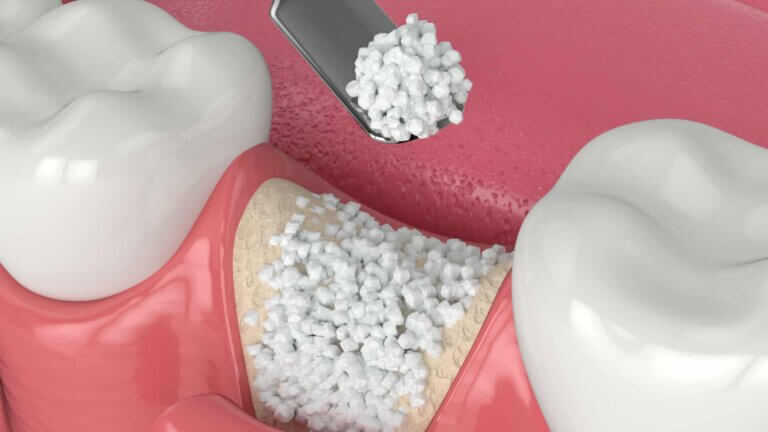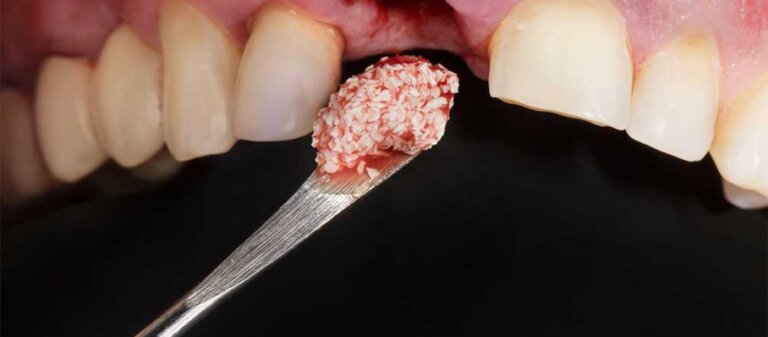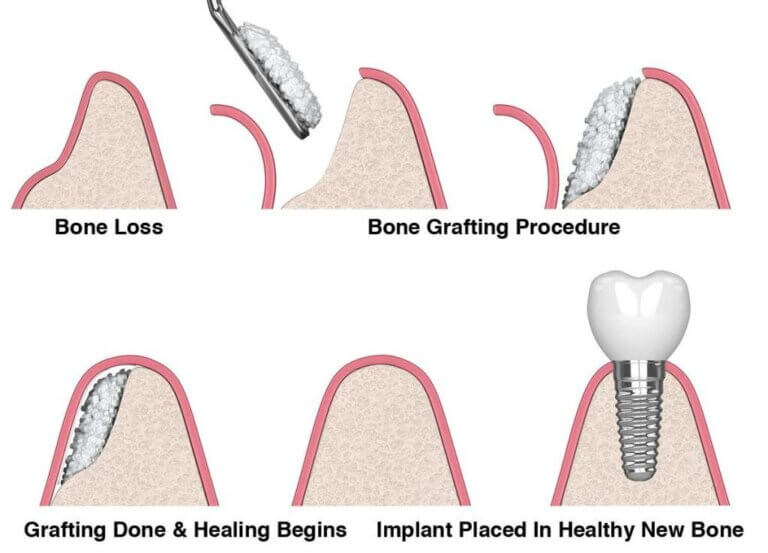Alveolar Bone Preservation

What Is Alveolar Bone Preservation?
Alveolar bone preservation is a dental procedure that involves placing a bone graft material into the tooth socket after a tooth extraction. The aim of this procedure is to preserve as much of the original bone ridge as possible to provide a stable foundation for a future dental implant. By maintaining the height and width of the alveolar bone, the patient is more likely to achieve a successful implant outcome both functionally and aesthetically. This procedure is often recommended for patients who are not yet ready for a dental implant, but are planning to replace a missing tooth in the near future.
Before you deciding on whether Alveolar bone preservation is right for you, there are some things you should know:
- Who Needs Alveolar Bone Preservation?
- Benefits of Alveolar Bone Preservation
- Type of Bone Graft Materials
- How Much Does Alveolar Bone Preservation Cost?
- Steps in the Alveolar Bone Preservation Procedure
- Frequently Asked Questions About Alveolar Bone Preservation
If you have any further questions about Alveolar bone preservation or other dental services offered at Atlas Dental, please contact us.

Free phone consultation
Have questions about Alveolar Bone Preservation? Schedule a free phone consultation with our Toronto dentist.

5 star google reviews
Our patients love us! See for yourself why more and more people are choosing Atlas Dental for Alveolar Bone Preservation.

Book In Person Consult Online
Book an in-person consult to discuss your Alveolar Bone Preservation case.
Who Needs Alveolar Bone Preservation?
Alveolar bone preservation is beneficial for patients considering dental implants in the future. Common scenarios where this procedure may be recommended include:
- Multi-Rooted Tooth Extractions: When a multi-rooted tooth (like a molar) is extracted, it can leave a larger socket. Bone preservation helps fill this gap and maintain the necessary bone dimensions for a planned implant.
- Active Dental Infections: Patients with dental infections may experience significant bone loss. This procedure aids in preventing further loss and supports bone regrowth for future implants.
- Delayed Implant Placement: If a dental implant cannot be placed immediately—due to the need for additional procedures like bone grafting—bone preservation can maintain the structure for future placement.
- Financial Considerations: Patients unable to afford immediate dental implants (which can exceed $5000 per tooth) can opt for bone preservation to maintain their bone structure until they are ready for the implant.
- History of Bone Loss: Patients with significant bone loss from conditions like periodontal disease can benefit from this procedure to prevent further deterioration.
In summary, alveolar bone preservation can be recommended in various situations to preserve the bone structure for a future dental implant and increase the chances of a successful implant outcome. If you have further questions about alveolar bone preservation, please contact us.

Benefits of Alveolar Bone Preservation
Alveolar bone preservation offers several advantages for patients who require tooth extractions and plan to have dental implants in the future. Some of the benefits of alveolar bone preservation include:
- Maintains bone volume and height: Alveolar bone preservation helps maintain the original height and width of the alveolar bone ridge after tooth extraction, which can prevent bone loss and help preserve the surrounding teeth’s position.
- Improves aesthetics: By maintaining the bone volume, alveolar bone preservation can provide a better aesthetic result, particularly in the front teeth area, by preventing the gum from receding and exposing the tooth root.
- Increases implant success rate: A stable bone structure is essential for the success of a dental implant. Alveolar bone preservation can improve the chances of a successful implant placement by providing a stable base for the implant.
- Reduces the need for additional bone grafting: When the bone structure is well-preserved, additional bone grafting procedures such as sinus lifts, may not be necessary during the implant placement process, reducing the need for additional surgery and cost.
- Shortens the implant treatment timeline: By preserving the bone structure, alveolar bone preservation can shorten the implant treatment timeline by allowing for faster implant placement and reducing the overall recovery time.
Type of Bone Graft Materials
There are various bone graft materials utilized for alveolar bone preservation:
- Allograft: Sourced from human donors, this sterilized bone is commonly used and is safe for patients.
- Xenograft: Derived from animal sources (bovine or porcine), this processed material is also safe and effective for bone preservation.
- Autograft: Taken from the patient’s own body (typically from the hip or jaw), autografts are considered the gold standard but require a second surgical site.
- Alloplasts: These are synthetic materials like calcium phosphate or Bioglass that can be used in bone grafting.
Patients should discuss the advantages and disadvantages of each option with their dentist to determine the best option for their individual needs. If you have further questions about alveolar bone preservation, please contact us.
Cost of Alveolar Bone Preservation
The cost of Alveolar bone preservation is $712. The codes relevant to Alveolar bone preservation in the Ontario Dental Association’s Suggested Fee Guide appear as follows:
Alveolar Bone Preservation – Allograft
- 72421 – First tooth: $362 + Dental Materials Expense (approximately $350)
Alveolar bone preservation is usually considered a supplementary service by dental insurance plans and may or may not be covered by your dental insurance. Be sure to find out from your dental insurance plan provider how much you are eligible for before going ahead with dental treatment. Your dentist can help you submit a predetermination to your dental insurance.
For patients without dental insurance, Atlas Dental is pleased to offer dental financing through iFinance Dentalcard. Affordable payment plans start at 7.95% for terms of 6 months to 6 years. To learn more about Dentalcard dental treatment financing, follow this link.

Steps in the Alveolar Bone Preservation Procedure
The procedure typically involves the following steps:
- Evaluation and Preparation: The dentist will assess the tooth requiring extraction through X-rays and intraoral exams. Antibiotics are usually prescribed to minimize infection risks.
- Tooth Extraction: The damaged tooth is carefully removed, preserving surrounding bone and tissue.
- Cleaning and Debridement: The extraction site is thoroughly cleaned to remove any debris or infection.
- Graft Placement: Bone graft material is inserted into the socket to fill the void. This material may come from the patient, a donor, or synthetic sources.
- Closure: The dentist will close the gum tissue over the socket using resorbable sutures. A collagen membrane may also be placed to secure the graft.
- Post-operative Care: Patients will receive post-operative instructions and may need follow-up appointments to monitor healing and plan for dental implant placement. A CBCT scan might be required for further assessment.
The alveolar bone preservation procedure is a straightforward and effective way to maintain as much bone as possible after a tooth extraction, which can provide a solid foundation for a future dental implant. If you have further questions about alveolar bone preservation, please contact us.
Frequently Asked Questions About Alveolar Bone Preservation
- Why is alveolar bone preservation important after tooth extraction?
Preserving the alveolar bone after a tooth extraction helps maintain the structure and stability of your jawbone. This is essential for future dental restorations, such as dental implants, and prevents issues like facial sagging or shifting of adjacent teeth.
- Can alveolar bone preservation prevent the need for future bone grafting?
Yes, alveolar bone preservation reduces the likelihood of needing additional bone grafting in the future. By maintaining the bone’s density and volume after tooth extraction, it creates a stable foundation for restorations like dental implants.
- Is alveolar bone preservation a painful procedure?
The procedure is performed under local anesthesia, so you won’t feel pain during the process. Some mild discomfort may occur during recovery, but it is manageable with over-the-counter pain relievers and proper aftercare.
- How long does it take to heal after alveolar bone preservation?
Healing typically takes several months, as the bone graft needs time to integrate with the surrounding tissue. Your dentist will monitor your progress and advise when you’re ready for additional treatments, such as dental implants.
For more information on alveolar bone preservation or to discuss your options, please contact us for more information.

